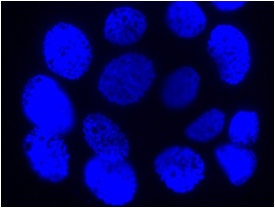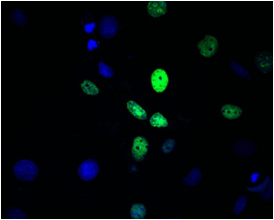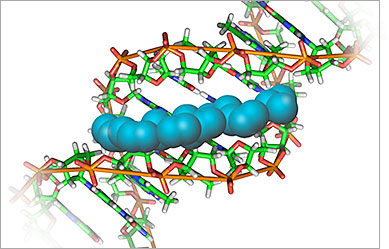Hoechst stains are part of a family of blue fluorescent dyes used to stain DNA. The emission is very bright, and for the purposes of the SP strategy, is detected at two emission wavelengths after UV excitation: Hoechst Red (630–6nM) and Hoechst Blue (405–4nM). Cellular Dyes for studying Hoechst in the Companion Products research area.
It is available as a ready-to- reconstitute, highly pure powder form, with only one dilution step required to obtain a ready-to-use solution. Excitation of the dye occurs around 3nm with an emission maxima around 4nm.

DNA ( preferentially binds to A-T base pairs). On binding to DNA, the fluorescence greatly increases. This dye is very useful to label . Hoechst dyes are cell membrane-permeant, minor groove-binding blue fluorescent DNA stains.
Either dye can be used to stain live . Because these fluorescent stains label DNA, they are also commonly used to visualize nuclei and mitochondria. Find product specific information. View more versions of this product.

Get expert to your questions in Cell Tracking, Transfection, Live Cell Imaging and CFSE Proliferation Assay and more on ResearchGate, the professional network for scientists. This kit contains two ready-to-use dyes bound to DNA. Labeled with specific fluorochromes so that they give rise to the same fluorescence spectra as cells labeled with the same fluorochromes.
Cells should be maintained in the media that is normal for their growth. Incubate for minutes at 37°C. Optimal incubation time will vary with cell type. Cells must be maintained in Hoechst, DO NOT wash out the stain. Put the samples on ice after . For cell cycle analysis and sorting of unfixed samples.
Requires ultraviolet argon laser excitation, 450nm emission. Binds preferentially to A-T base regions in DNA. Non-intercalative DNA binding. DiOCcan increase resolution of DNA distribution.
TechSupport-Hoechst This brief tutorial demonstrates. At the time, this finding represented a source of frustration . Reagents: Hoechst-IMDM Media (stored at 4oC).

IMDM with FBS, 1mM HEPES and Pen-Strep. A promising and increasingly exploited property of hematopoietic stem cells is their ability to efflux the fluorescent dye. The Hoechst-negative cells are isolated by fluorescence- activated cell sorting as a so-called side. SP from bone marrow, as well as other tissues, is . Pharmacokinetics, binding and distribution of Hoechst. Avenue, Vancouver, British Columbia, Canada.
Cancer Research Centre, 6W. It can be used to examine cellular DNA in most fluorescent applications. You can also browse global suppliers,vendor,prices,Price,manufacturers of Hoechst . They fluoresce strongly when bound to DNA, but are not visible .